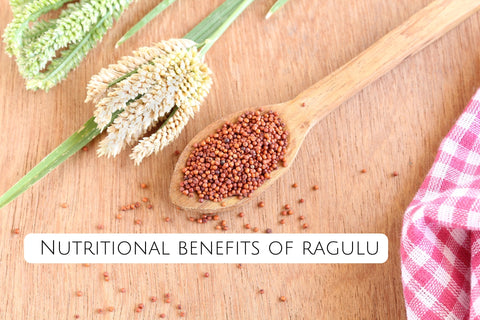"Ragulu" is a term commonly used in some regions, especially in India, to refer to finger millet, known scientifically as Eleusine coracana. Finger millet is a type of millet that has been cultivated for thousands of years and is a staple in certain diets. Here are some of the nutritional benefits of ragulu or finger millet:
Rich in Nutrients:
Ragi is a nutritious grain that is rich in protein, fiber, calcium, iron, and other minerals. It is a good source of antioxidants and has been shown to have a number of health benefits, including:
Improving digestion:
Ragi is a good source of fiber, which helps to regulate digestion and prevent constipation.
Boosting immunity:
Ragi is rich in antioxidants, which help to protect the body from damage caused by free radicals.
Promoting bone health:
Ragi is a good source of calcium, which is essential for strong bones and teeth.
Lowering blood sugar levels:
Ragi has a low glycemic index, which means that it does not cause a rapid spike in blood sugar levels. This can be beneficial for people with prediabetes or diabetes.
Reducing cholesterol levels:
Ragi has been shown to help lower LDL (bad) cholesterol levels.
Promoting weight loss: Ragi is a good source of fiber, which can help you feel full and satisfied and may help you lose weight or maintain a healthy weight.
High in Calcium:
Ragi, also known as finger millet, is a nutritious grain that is exceptionally rich in calcium. In fact, it is one of the best plant-based sources of calcium, with 344mg per 100g. This is significantly higher than other commonly consumed calcium-rich foods like milk (300mg per cup), yogurt (450mg per cup), and kale (180mg per cup).
Ragi's high calcium content is due to the presence of phytic acid, a compound that binds to calcium and prevents it from being absorbed in the gut. However, ragi also contain the enzyme phytase, which breaks down phytic acid and releases calcium for absorption.
Good Source of Iron:
Ragi is indeed a good source of iron, with approximately 2.7 mg of iron per 100 grams. This makes it a valuable addition to the diet for individuals who are at risk of iron deficiency or anemia. Iron plays a crucial role in the body's oxygen transport system, enabling red blood cells to carry oxygen from the lungs to various tissues.
As you can see, ragi provides a comparable amount of iron to other iron-rich foods, such as spinach and lentils. However, it's important to note that the bioavailability of iron from plant-based sources is generally lower than that from animal sources. This means that the body may not absorb iron from plant-based foods as efficiently.
Rich in Magnesium:
Magnesium is important for the proper functioning of enzymes and muscles, and finger millet contains a good amount of this mineral. Ragi is a rich source of magnesium, containing approximately 270 mg of magnesium per 100 grams. This makes it a valuable addition to the diet for individuals who are looking to increase their magnesium intake and reap its numerous health benefits. Magnesium is an essential mineral that plays a major role in various bodily functions, including:
- Regulating muscle and nerve function: Magnesium helps muscles contract and relax properly, and it also supports nerve impulse transmission.
- Maintaining blood sugar levels: Magnesium plays a role in insulin sensitivity and glucose metabolism, helping to regulate blood sugar levels.
- Controlling blood pressure: Magnesium contributes to maintaining healthy blood pressure by relaxing blood vessels and reducing blood vessel resistance.
- Supporting bone health: Magnesium is involved in bone formation and remodeling, contributing to strong and healthy bones.
- Promoting protein synthesis: Magnesium is essential for protein synthesis, which is the process of building and repairing tissues.
Aids in Digestion:
The dietary fiber in finger millet supports healthy digestion and can help prevent constipation. Ragi, also known as finger millet, is a grain that can aid in digestion due to its high fiber content. Fiber helps to regulate digestion by adding bulk to stool, stimulating bowel movements, and preventing constipation. Additionally, ragi contains prebiotics, which are non-digestible fibers that feed the beneficial bacteria in your gut. These gut bacteria play a crucial role in maintaining digestive health and promoting overall well-being.
Here are some of the specific ways in which ragi aids in digestion:
Promotes Regular Bowel Movements:
The insoluble fiber in ragi adds bulk to stool, making it easier to pass through the intestines. This helps to prevent constipation and promote regular bowel movements, which are essential for maintaining digestive health.
Enhances Nutrient Absorption:
Ragi's soluble fiber slows down the absorption of glucose into the bloodstream, preventing blood sugar spikes and promoting satiety. It also helps to trap bile acids, which leads to the excretion of cholesterol and reduces cholesterol levels in the blood.
Nourishes Gut Bacteria:
Ragi contains prebiotics, which are non-digestible fibers that serve as food for the beneficial bacteria in your gut. These bacteria produce short-chain fatty acids, which provide energy for the gut cells and promote overall gut health.
Improves Gut Barrier Function:
The prebiotics in ragi help to strengthen the gut lining, reducing intestinal permeability and preventing harmful substances from entering the bloodstream.
Eases Digestive Issues:
Ragi's high fiber content and prebiotics can help alleviate digestive issues such as bloating, gas, and diarrhea.
Low Glycemic Index:
Ragi, also known as finger millet, has a low glycemic index (GI) of around 54. This means that consuming ragi causes a relatively slow and sustained increase in blood sugar levels compared to foods with a high GI. For reference, a low GI is considered to be below 55, a medium GI ranges from 55 to 70, and a high GI is above 70.
The low glycemic index of ragi is attributed to its high fiber content and complex carbohydrates. Fiber slows down the digestion of carbohydrates, preventing them from being absorbed into the bloodstream too quickly. This helps to regulate blood sugar levels, which is particularly beneficial for individuals with diabetes or prediabetes.
Gluten-Free:
ragi is a naturally gluten-free grain, making it a suitable choice for individuals with gluten sensitivities or celiac disease.
Ragi, being gluten-free, is a safe and nutritious alternative to wheat-based grains. It can be used to make a variety of dishes, including porridge, roti, idli, dosa, cookies, and cakes. Additionally, ragi is a good source of protein, fiber, iron, calcium, and other essential minerals, making it a valuable addition to a gluten-free diet.
Here are some specific reasons why ragi is a good choice for gluten-free diets:
Naturally Gluten-Free:
Ragi is inherently gluten-free, meaning it does not contain any gluten proteins that can trigger adverse reactions in individuals with gluten intolerance.
Versatile Culinary Applications:
Ragi can be used in a variety of dishes, from breakfast porridge to savory rotis, fluffy idlis, and crispy dosas. It can also be incorporated into baked goods like cookies and cakes.
Nutritional Powerhouse:
Ragi is a rich source of protein, fiber, iron, calcium, and other essential minerals, providing essential nutrients for overall health and well-being.
Easy to Digest:
Ragi's high fiber content aids in digestion and promotes regular bowel movements, contributing to digestive health.
Rich in Antioxidants:
Ragi is a rich source of antioxidants, which are compounds that protect cells from damage caused by free radicals. Free radicals are unstable molecules that can contribute to aging, chronic diseases, and cancer. Antioxidants help to neutralize free radicals, preventing them from causing harm.
Ragi contains several different types of antioxidants, including:
Phytic acid, flavonoids, phenolic acids, tannins.
Promotes Weight Management:
Ragi, also known as finger millet, is a nutritious grain that has been shown to promote weight management in several ways.
Here are some of the ways that ragi can help with weight management:
High fiber content, and low calorie count, may reduce fat absorption, improve insulin sensitivity.
Supports Heart Health:
Some studies suggest that finger millet may have cardiovascular benefits, including the potential to lower blood pressure and reduce cholesterol levels.
In conclusion, ragi is a nutritious whole grain that offers a range of health benefits. However, it's important to remember that a balanced diet includes a variety of foods from different food groups.




Comments (0)
There are no comments for this article. Be the first one to leave a message!